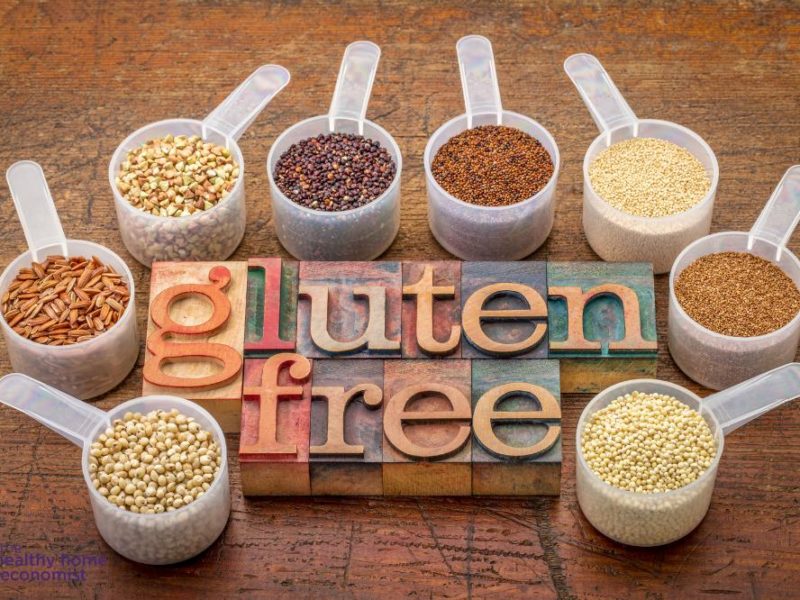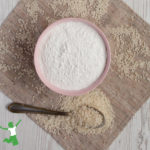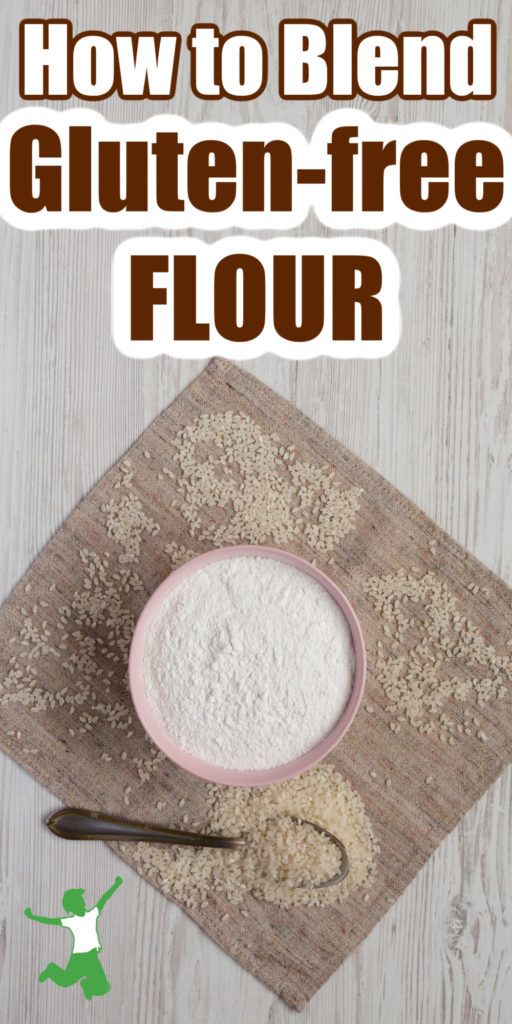Table of Contents[Hide][Show]
The complete guide on homemade gluten-free flour, with detailed instructions on how to mix and use the many different types and easy recipes to bake and enjoy.

A growing number of people are having problems tolerating gluten, a complex and difficult to digest plant protein. If you find this hard to believe, check out your local health food store. An entire aisle in one in my community is devoted to products made with gluten-free flour! A growing number of people are also interested in learning how to make gluten-free flour.
For some, the issues with gluten result from a genetic predisposition that can lead to Celiac disease, an autoimmune disorder where the consumption of gluten leads to damage to the small intestine. Celiac is estimated to affect 1 in 100 people worldwide, according to the Celiac Disease Foundation.
Gluten Sensitivity is Widespread
For millions of others, up to 15% of the population who don’t qualify as Celiacs, gluten is simply not well tolerated digestively. A wide variety of symptoms are attributed to gluten intolerance including brain fog, depression, ADHD-like behavior, abdominal pain, bloating, diarrhea, constipation, headaches, bone or joint pain, and chronic fatigue.
The widespread nature of Celiac and gluten sensitivity makes it highly probable that you will have a friend or relative with this condition come to dinner or a party at your home at some point in the future if it hasn’t happened already!
As a result, I consider baking with homemade gluten-free flour to be an essential skill in order to accommodate these folks without any loss of enjoyment for the guests who are able to tolerate wheat.
Successful gluten-free baking tastes as yummy to those who eat wheat as it does to those who don’t!
I guarantee that if you learn to bake with gluten-free flour, your baked goods will be a big hit at school and community events. More people are gluten-free than you might think!
If you would like to learn to bake gluten-free to provide options for your gluten intolerant or Celiac friends and family or to just mix it up in your own home once in a while to give everyone a break from wheat (most people eat far too much!), below is a simple guide for mixing all-purpose gluten-free flour that you can use as an easy substitute for your wheat-based recipes.
Mixing Homemade Gluten-Free Flour as a Substitute for Wheat
The problem with gluten-free baking is that the gluten itself is the very ingredient that holds moisture and binds everything together.
Gluten is food glue, so to speak.
No wonder food manufacturers love it so much and even add additional vital wheat gluten to some products to make them especially sturdy and non-crumbly. Mass production of cookies, crackers, and other processed carbs is a much more difficult process when the gluten is removed.
This is why a simple substitution of wheat with a gluten-free flour doesn’t work very well. Things fall apart and just don’t have the right consistency.
According to Becky Mauldin ND, author of Recipes for Life, the best results using gluten-free flour as a substitute for wheat flour are obtained by using at least two gluten-free flours blended together as it gives a better texture and flavor.
Gluten-free flours can be categorized into crumbly flours or binding flours. Your gluten-free flour mix of choice should include a crumbly flour (2 is better) and a small amount of one or two binding flours.
Of course, you can buy an all-purpose gluten-free flour mix from the store, but the flour will be essentially nutritionless. It is always best to grind fresh and blend gluten-free flour yourself as much as possible just the same as if you were using wheat. Here is an overview of the many choices available to you.
Crumbly Gluten-Free Flours
These flours do not hold together very well when baked. They are best blended with one or more binding flours rather than used alone or in combination with each other.
- Rice – The best choice when first attempting to bake with gluten-free flour. White rice flour is more easily digested and less allergenic than brown rice flour. Always get good quality to avoid rice heavy metal contamination.
- Amaranth – Always needs a binding flour with it. Good for cakes, cookies, and pancakes.
- Plantain or Banana – High in beneficial resistant starch and good for those who are also grain-free.
- Teff – Has a delicious, mildly nutty flavor and easy to digest. Teff is wonderful for bread, pancakes, and waffles. Not all grain grinders can handle teff as the grains are so tiny (smaller than chia seeds).
- Quinoa – Harder to digest than other gluten-free flours unless thoroughly soaked and cooked first.
- Oats – Mild tasting and makes great bread.
- Coconut – Easily make your own coconut flour with desiccated coconut pulsed in a food processor. It is typically used alone with eggs as the binding agent (see below).
- Nuts and Seeds– A good choice if using soaked nuts or seeds, else the high level of anti-nutrients makes them very hard to digest.
- Corn – Make sure to buy organic as most nonorganic corn is genetically modified. Avoid highly refined cornstarch and stick with whole-grain forms.
- Millet – Use no more than 1/5 of the total flour mix as using more tends to produce a very dry baked good.
- Sorghum – Similar to millet, sorghum is best used in smaller quantities and blended with another crumbly gluten-free flour like rice or teff.
Binding Gluten-Free Flours
These flours bind together reasonably well and don’t crumble easily when baked.
- Arrowroot – The best choice of the binding flours. Easy to digest, unrefined, and the most nutritious (where to find).
- Buckwheat – Use very small amounts as it has a very strong flavor. Best to always grind fresh as store-bought buckwheat flour tends to be bitter.
- Tapioca – Good in small quantities, good for coating anything to be fried. Imparts a chewier texture. Cassava is its more unprocessed form and is more nutritious.
- Acorn – Acorn flour naturally contains a gluten-like binder when made from acorns that were soaked instead of boiled to remove the bitter tannins.
- Potato – Highly refined and low in nutrients. Arrowroot is a healthier choice. Potato starch is better than the flour as it is high in beneficial resistant starch.
- Legume (pea, lentil, gram flour) – Beware, as anti-nutrients make these flours particularly hard to digest.
- Skip the soy flour – You don’t need the hormone disruption in your life! Beware as many gluten-free products in the store contain it (scientific evidence soy is bad for hormones).
Binder Options
Once you’ve blended your crumbly and binding gluten-free flours together, you must select a binding agent to hold everything together in the absence of gluten doing the job.
- Egg – The most nutritious binder of all. May be used in addition to xanthan gum for extra firmness.
- Flax gel (egg substitute) – Check out my recipe plus video how-to on making an egg substitute. Use 4 Tbl of the gel as the substitute for 1 egg. Tip: for extra lightness, Ms. Mauldin suggests whipping the gel and folding through the batter at the end of mixing. Do not use aquafaba made from chickpea water as it is loaded with anti-nutrients and dangerous to gut health.
- Chia seed gel – Similar to flax gel, use 4 Tbl of the chia seed gel as a substitute for 1 egg. Fold into the batter at the end of mixing as described above.
- Guar gum – Some people with sensitive digestion react to this so probably best to avoid unless absolutely necessary.
- Xanthan – Not as good as guar gum, but most people tolerate it quite well. Just be sure to source organic or nonGMO as it is usually made from fermented corn sugar. It can be made from wheat as well, so make sure it is guaranteed gluten-free (where to find).
Do not use psyllium as it encourages candida growth.
Homemade All-Purpose Gluten-Free Flour
Below are several recipes for a homemade gluten-free flour that are slightly adjusted depending on the type of baked good. Let’s begin with a recipe for all-purpose gluten-free flour.

All-Purpose Gluten-Free Flour Recipe
Easy recipe for mixing a basic gluten free flour as a baking substitute for all purpose flour or whole wheat flour.
Ingredients
- 3/4 cup rice flour remember that white rice flour is easier to digest.
- 3 Tbl arrowroot flour
- 1 Tbl tapioca starch
- 1/2 tsp xanthan gum
Instructions
-
If a given recipe calls for 1 cup of wheat flour, substitute with this all-purpose gluten-free flour mix above maintaining roughly the same proportions if you need more flour.
-
This gluten-free flour blend can be used as a quick and easy substitute for wheat flour in just about any recipe!
Whole Grain GF Bread Flour Recipe
Please note that while this combination for whole grain bread flour contains some added starch, it is in the form of plantain flour (or tapioca starch if preferred), both of which are healthy forms of resistant starch for the gut. This recipe for gluten free banana bread is a good one to try with this blend.
Substitute the following proportions for each cup of wheat flour:
- 5 Tbl sorghum flour
- 4.5 Tbl plantain flour, banana flour or tapioca starch (where to find)
- 3 Tbl teff flour
- 2 Tbl millet or quinoa flour
- 1.5 Tbl brown rice flour
- 1/2 tsp xanthan gum (where to find)
Cake Flour Recipe
This combination of gluten-free cake flour works well for making a delicious gluten-free pound cake. Instead of 2 cups of wheat flour use:
- 1 1/4 cup white rice flour
- 1/2 cup sorghum flour
- 1/4 cup arrowroot flour (where to find).
- 1 tsp xanthan gum (where to find)
Sift 2 tsp baking powder and 1/4 tsp sea salt with this gluten-free flour mix and then blend in 1 cup melted butter beaten with 1 cup sucanat, 4 eggs, plus 2 tsp vanilla and you have your batter for gluten-free pound cake!
Muffin Flour Recipe
For muffins, try this gluten-free flour mix instead of 2 cups wheat flour. Adjust proportionally for more or less flour:
- 1 1/4 cups brown or white rice flour
- 1/4 cup sorghum or millet flour
- 1/2 cup arrowroot flour (where to find)
- 1 tsp xanthan gum (where to find)
The best way to figure out what combination of gluten-free flours you like best is to experiment! Hopefully, these guidelines plus the DIY gluten-free flour substitutions suggested above depending on the baked good you are making get you well on your way to years of successful gluten-free baking.
More Options Using GF Flour
Looking for some healthy recipes to use your homemade flour? Try these:
- Gluten-free pizza crust recipe
- Old fashioned peanut butter cookies
- Pumpkin cookies
- Gluten-free waffle recipe

References
Going Gluten-Free by Becky Mauldin ND
More Information
The Real Reason Wheat is Toxic (It’s Not the Gluten)
The Good Gluten You Can Probably Eat Just Fine
The Dirty Little Secret About Gluten-Free
What? White Rice Better than Brown?








HOW WOULD YOU RATE BOB’S RED MILL 1×1 MIX?
I am intolerant of carbs and have quit using flour. What could I use to coat my beef liver and also make a gravy when I cook liver?
Thickening with egg yolks is probably your best bet.
Just adding another possible binding gluten-free flour: SWEET RICE FLOUR. AKA Glutinous Flour (not anything related to gluten for celiac – no worries – it is purely rice). Made from short grain rice – it is “stickier”. In a recipe that has white rice flour, I swap in about 25% sweet rice flour so it is less crumbly than white alone. Up to 33% sweet rice flour works in some recipes – be start lower. If you go too high, it will be a goopy gummy baked item. I believe it is used to make “mochi” – a Japanese (I think) treat … popular in Philippines and other countries too. My brand is Authentic Foods – they have ultra fine flours that aren’t contaminated with oats (I can’t do gluten free oats of any kind).
I work on my recipes over and over slowly until the don’t need any gums – have been successful but you have to keep good notes so you know what does and doesn’t help.
ALSO: COCONUT BUTTER: I’ve found adding coconut butter (basically pureed raw coconut meat. I use Artisana Organics safely) seems to help gain binding and rising properties of my muffin and soda bread recipes for example – found that by trial and error. I add 20 or more grams coconut butter (softened) to about 400 grams weight of banana muffin batter for example (mix in right before mixing the leaveners at the end) – that amount of batter for me makes 3 really large muffins in ramekins.)
Hope it helps someone! 🙂
I am sorry! I read it too quickly! Thank you.
Hi Sarah. You did not mention cassava flour or almond flour for baking. Especially cassava flour which seems to be a 1:1 for wheat. What are your thoughts on these two flours? Thank you!
Cassava actually is mentioned if you look again. It is simply the less processed form of tapioca flour. Here’s more info on cassava specifically. https://www.thehealthyhomeeconomist.com/cassava-benefits-starch-flour/
Almond flour isn’t mentioned as nut flours are completely different than gluten free flours as it is also starch free. https://www.thehealthyhomeeconomist.com/almond-flour/
I have been following the Blood Type diet by Dr. D’Adamo. I am type O and the diet says for me to avoid most all dairy products and to avoid wheat products. I have been following this diet for about 6-8 months now and have not gotten a fever blister or had any sinus trouble. I feel a lot better as well.